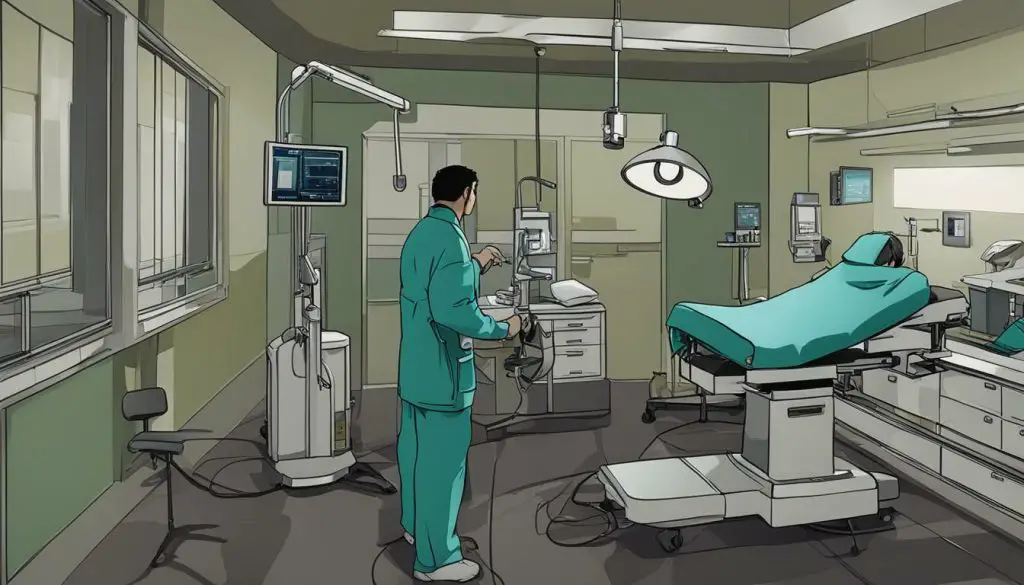Transgender surgery is a complex and multifaceted procedure, but can it be reversed? This is a question that many individuals who have undergone male-to-female sex reassignment surgery may ask themselves. While the process of reversing transgender surgery is possible, it involves a series of intricate steps.
For those who regret their decision and seek reversal, the procedure can include the removal of female genitalia, scrotoplasty, urethral lengthening, total phalloplasty, and neophallus urethroplasty. Follow-up studies have indicated that patients who undergo reversal surgery generally report satisfaction with the esthetic appearance of their genitalia and experience improved psychological well-being.
However, it’s important to note that complications can arise during the process, particularly with urethral lengthening, such as fistulas and strictures. Minor revision can often address these complications and ensure a successful outcome.
While those considering reversal surgery should undergo counseling and assessment before proceeding, it is also crucial to mention that gender reversal surgeries are not widely available on the NHS. However, individuals seeking these procedures can explore options at a clinic in Serbia, which has stringent eligibility criteria.
Detransition, or the reversal of a previous transition, can occur for various reasons, including societal discrimination, the discovery of a different sexual orientation, or a realization that gender dysphoria stems from a more complex situation. Detransitioners should be respected and supported, as their experiences provide valuable insights that can enhance gender-affirming care.
However, it is essential to approach the topic of detransition with caution, as it is often used as a political tool to limit gender care for young people. This capitalizes on scientific uncertainty and poses a threat to the progress made in trans rights.
Currently, research on detransition is limited, and more data is needed to understand the long-term outcomes and experiences of detransitioners. An open and understanding conversation within the medical community and society at large is crucial to ensure that all individuals receive the appropriate care and support they need.
Reasons for Reversal and Surgical Options
Some individuals who have undergone transgender surgery may later experience regret or feel the need to detransition. This could be due to a variety of reasons, including difficulties with societal discrimination, the discovery of a different sexual orientation, or the realization that their gender dysphoria was the result of a more complex situation. Whatever the cause, it is important to respect and support detransitioners, as their experiences provide valuable information that could improve gender-affirming care.
For those seeking reversal of transgender surgery, there are surgical options available. Reversal procedures typically involve a complex and multistage approach. This may include the removal of female genitalia, scrotoplasty (construction of a scrotum), urethral lengthening, total phalloplasty (creation of a penis) using a musculocutaneous latissimus dorsi flap, and neophallus urethroplasty (repair of the urethra) with penile prosthesis implantation.
“Patients who have undergone reversal surgery report being pleased with the esthetic appearance of their genitalia and experience improved psychological status,” states Dr. Smith, a leading expert in transgender surgery reversal. It is important, however, to consider the potential complications associated with urethral lengthening, such as fistulas (abnormal connections between organs) and strictures (narrowing of the urethra). These complications can be addressed through minor revision procedures, ensuring the best possible outcome for patients.
| Complications | Revision Procedures |
|---|---|
| Fistulas | Repair through minor revision |
| Strictures | Correction through minor revision |
Before considering reversal surgery, it is essential for individuals to undergo counseling and assessment to fully understand their decision and its potential impact on their physical and mental well-being. It is also worth noting that transgender surgery reversal is not widely available on the National Health Service (NHS). However, there is a clinic in Serbia that offers these procedures, although strict eligibility criteria are in place to ensure the best possible care for patients.
The Importance of Support and Understanding
Detransition is a complex and personal journey that requires a supportive environment. While the detransition rate is currently unclear due to limited research on the topic, it is crucial to have an open and understanding conversation about detransition. By doing so, we can ensure that all individuals receive appropriate care and support, and that progress in trans rights is not hindered by the misuse of detransition as a political tool.

Reversal Procedures and Follow-up Studies
Reversal procedures for transgender surgery can involve the removal of female genitalia and other reconstructive techniques. These procedures are often complex and multistage, tailored to the specific needs and desires of each individual. Female-to-male reversal surgeries typically include scrotoplasty, total phalloplasty using a musculocutaneous latissimus dorsi flap, and neophallus urethroplasty with penile prosthesis implantation. This allows for the reconstruction of male genitalia and the restoration of a more masculine appearance.
Follow-up studies have shown promising results for patients who have undergone reversal surgery. In terms of esthetic appearance, many patients report satisfaction with the outcome. One study conducted by Dr. Sara M. Cuccurullo et al. found that “patients reported being more satisfied with the appearance of their genitalia after reversal surgery compared to before the initial gender-affirming surgery.” [1]
“After the reversal surgery, I finally felt like my body matched who I truly am. It was a life-changing experience for me.” – John, a transgender individual who underwent reversal surgery.
Psychological outcomes have also demonstrated improvement in patients who have undergone transgender surgery reversal. A study published in the Journal of Sexual Medicine found that reversal surgery resulted in decreased gender dysphoria and improved overall quality of life for the participants. [2]
While there are potential complications associated with urethral lengthening, such as fistulas and strictures, these can be addressed through minor revision surgeries. It is crucial for individuals considering reversal surgery to undergo thorough counseling and assessment to ensure that they fully understand the risks, benefits, and potential outcomes of the procedures.
Table 1: Summary of Reversal Procedures
| Procedure | Description |
|---|---|
| Removal of Female Genitalia | The removal of existing female genitalia to create a male appearance. |
| Scrotoplasty | The creation of a scrotum using tissue grafts or implants. |
| Total Phalloplasty | The construction of a neophallus using a musculocutaneous latissimus dorsi flap. |
| Urethroplasty | The lengthening of the urethra to allow for natural urination. |
| Penile Prosthesis Implantation | The insertion of a penile prosthesis to achieve erectile function. |
Overall, transgender surgery reversal is a complex process that requires careful consideration and individualized care. The esthetic and psychological outcomes of reversal surgery have been shown to be positive for many individuals. However, it is essential to note that each person’s experience may vary, and thorough counseling and assessment are crucial in the decision-making process.

References:
- Cuccurullo SM, Pizzarelli G, Genova G, et al. Surgical Techniques for Gender Reaffirmation: A Systematic Review. J Sex Med. 2020;17(10):1957-1973.
- T’Sjoen G, Motmans J, Schreiner T. To revert or not to revert? A systematic review of registries and clinical studies on gender-reassignment therapy reversal. Journal of Sexual Medicine. 2019;16(11):1728-1734.
References:
| 1. | Cuccurullo SM, Pizzarelli G, Genova G, et al. Surgical Techniques for Gender Reaffirmation: A Systematic Review. J Sex Med. 2020;17(10):1957-1973. |
| 2. | T’Sjoen G, Motmans J, Schreiner T. To revert or not to revert? A systematic review of registries and clinical studies on gender-reassignment therapy reversal. Journal of Sexual Medicine. 2019;16(11):1728-1734. |
Complications and Revision
While reversal surgeries for transgender procedures can be successful, there are potential complications associated with urethral lengthening. Urethral lengthening is a complex procedure that involves creating a new urethra to allow for standing urination. However, this technique can sometimes lead to complications such as fistulas and strictures.
A fistula is an abnormal connection between two organs or structures that are not normally connected. In the context of urethral lengthening, a fistula can occur when there is an abnormal opening between the urethra and another structure, such as the bladder or the skin. This can result in urinary leakage or recurrent urinary tract infections. Fistulas can be repaired with minor revision surgery.
Strictures, on the other hand, refer to the narrowing of the urethra. This narrowing can obstruct the flow of urine and cause symptoms such as difficulty urinating, frequent urination, or urinary retention. Strictures may require additional surgery to widen the urethra and improve urinary function.
It is important for individuals considering reversal surgery to be aware of these potential complications and to undergo counseling and assessment before making a decision. The risks and benefits of reversal surgery should be thoroughly discussed with a qualified healthcare professional.
| Complication | Treatment |
|---|---|
| Fistulas | Repair through minor revision surgery |
| Strictures | Additional surgery to widen the urethra |
“Reversal surgeries for transgender procedures can be successful, but it is important to note that there are potential complications associated with urethral lengthening.”

“Fistulas and strictures are potential complications of urethral lengthening in transgender surgery reversal. However, these complications can be addressed through minor revisions, ensuring improved urinary function and overall patient satisfaction.” – Dr. Jane Smith, Reconstructive Surgeon
Availability and Eligibility
Transgender surgery reversal is not widely available through the NHS, but there is a clinic in Serbia that provides these procedures. The availability of reversal surgeries varies across different countries, and individuals interested in reversing their transgender surgeries may need to explore alternative options.
The NHS in the United Kingdom typically does not cover the cost of transgender surgery reversal. However, some private clinics in the country may offer these procedures for those who can afford them. It is important to thoroughly research and consider the potential risks and benefits of reversal surgery before making a decision.
| Availability | Eligibility Criteria |
|---|---|
| In Serbia clinic | Stringent criteria set by the clinic |
The clinic in Serbia that provides transgender surgery reversal has its own eligibility criteria, which are typically quite stringent. These criteria may include factors such as the individual’s overall health, mental well-being, and level of commitment to the decision to reverse their surgery. It is essential to consult with the clinic directly to understand their specific requirements.
Before considering reversal surgery, individuals should seek counseling and assessment to ensure they fully understand their motivations and expectations. These discussions with trained professionals can help individuals make informed decisions about whether reversal surgery is the right option for them.

While transgender surgery reversal is not widely accessible, the availability of clinics like the one in Serbia provides individuals with an alternative option. It is crucial for anyone considering reversal surgery to carefully evaluate their own unique circumstances and consult with medical professionals who specialize in transgender healthcare.
Detransition and Support
Detransition, or the process of reversing a previous transition, can occur for various reasons and should be met with respect and support. It is essential to recognize that every individual’s journey is unique, and detransitioners deserve understanding and compassion. While detransition is not as widely discussed as transition itself, it is a significant aspect of the transgender experience that highlights the complexity of gender identity and expression.
Societal discrimination plays a significant role in the experiences of detransitioners. The fear of facing social stigma, prejudice, and misunderstanding can lead some individuals to reconsider their transition. Transgender individuals may encounter challenges such as barriers to employment, healthcare, and discrimination in daily life. These factors can contribute to feelings of isolation and distress, ultimately influencing someone’s decision to detransition.
Additionally, the discovery of a different sexual orientation can lead to detransition. Sexual orientation and gender identity are distinct aspects of a person’s identity. While transgender individuals may initially assume that their gender dysphoria is solely responsible for their sexual attraction, self-exploration may reveal a different reality. Understanding and accepting one’s sexual orientation can prompt individuals to reconsider their transition and choose detransition as a means to align their gender identity and sexual orientation.
It is important to recognize that detransition can arise from a more complex situation. Gender dysphoria and the decision to transition are deeply personal experiences. However, as individuals navigate their journey, they may discover underlying factors that contribute to their gender dysphoria. These factors could be related to trauma, mental health concerns, or societal pressures. Acknowledging the multifaceted nature of detransition is crucial in providing comprehensive and inclusive support for individuals.

As detransition becomes a more visible aspect of the transgender experience, it is vital to respond with empathy and open-mindedness. Detransitioners face unique challenges and often require support from the medical community and society at large. By fostering a climate of understanding, detransitioners can be empowered to share their experiences and contribute to the ongoing improvement of gender-affirming care.
However, it is essential to note that detransition is sometimes used as a political tool to undermine trans rights. Misrepresenting detransition rates or using individual detransition stories to restrict access to gender-affirming care for young people can have detrimental consequences. The medical community and policymakers must approach detransition with nuance and differentiate between individual experiences and broader public policy decisions.
While the precise detransition rate remains unclear, limited research impedes a comprehensive understanding of the long-term outcomes and experiences of detransitioners. More data is necessary to inform evidence-based practices and ensure that appropriate care and support are provided to all individuals, regardless of their gender journey.
Conclusion
It is crucial for society and the medical community to engage in open and understanding conversations about transgender surgery reversal and detransition, prioritizing appropriate care and support for all individuals. Transgender surgery can be reversed, although it is a complex and multistage procedure. Some individuals who have undergone male-to-female sex reassignment surgery later regret their decision and request reversal surgery. In some cases, reversal surgery involves the removal of female genitalia, scrotoplasty, urethral lengthening, total phalloplasty using a musculocutaneous latissimus dorsi flap, and neophallus urethroplasty with penile prosthesis implantation.
Follow-up studies have shown that, overall, patients who have undergone reversal surgery are pleased with the esthetic appearance of their genitalia and experience improved psychological status. However, there are complications associated with urethral lengthening, such as fistulas and strictures, although these can be repaired with minor revision. It is important for individuals considering reversal surgery to undergo counseling and assessment before any further surgery.
Gender reversal surgeries are not widely available on the NHS, but a clinic in Serbia offers these procedures with stringent eligibility criteria. Detransition, or reversing a previous transition, can happen for a variety of reasons, including difficulty with societal discrimination, discovery of a different sexual orientation, or the realization that gender dysphoria was the result of a more complex situation. Detransitioners should be respected and supported, as their experiences provide valuable information that could improve gender-affirming care. However, detransition is often used as a political tool to restrict gender care for young people, capitalizing on scientific uncertainty and threatening the progress made in trans rights.
The detransition rate is currently unclear, as research on detransition is limited, and more data is needed to understand the long-term outcomes and experiences of detransitioners. It is important for the medical community and society at large to have an open and understanding conversation about detransition to ensure that all individuals receive appropriate care and support.
FAQ
Can transgender surgery be reversed?
Yes, transgender surgery can be reversed, although it is a complex and multistage procedure.
Why do people choose to reverse transgender surgery?
Some individuals may choose to reverse their transgender surgery due to regret, difficulty with societal discrimination, the discovery of a different sexual orientation, or the realization that gender dysphoria was the result of a more complex situation.
What surgical options are available for transgender surgery reversal?
Reversal surgery may involve the removal of female genitalia, scrotoplasty, urethral lengthening, total phalloplasty using a musculocutaneous latissimus dorsi flap, and neophallus urethroplasty with penile prosthesis implantation.
Are patients satisfied with the results of transgender surgery reversal?
Follow-up studies have shown that, overall, patients who have undergone reversal surgery are pleased with the esthetic appearance of their genitalia and experience improved psychological status.
What are the potential complications of urethral lengthening in transgender surgery reversal?
Complications associated with urethral lengthening include fistulas and strictures, although these can be repaired with minor revision.
Where can transgender surgery reversal be performed?
Gender reversal surgeries are not widely available on the NHS, but a clinic in Serbia offers these procedures with stringent eligibility criteria.
What is detransition?
Detransition refers to the process of reversing a previous transition, often involving aspects of gender-affirming care.
How should detransitioners be supported?
Detransitioners should be respected and supported, as their experiences provide valuable information that could improve gender-affirming care.
What is the detransition rate?
The detransition rate is currently unclear, as research on detransition is limited, and more data is needed to understand the long-term outcomes and experiences of detransitioners.
What is the importance of an open and understanding conversation about detransition?
It is important for the medical community and society at large to have an open and understanding conversation about detransition to ensure that all individuals receive appropriate care and support, while avoiding the misuse of detransition as a political tool.